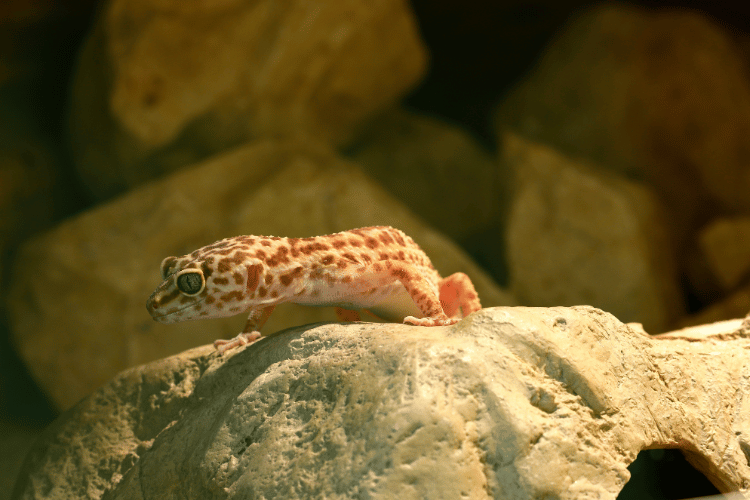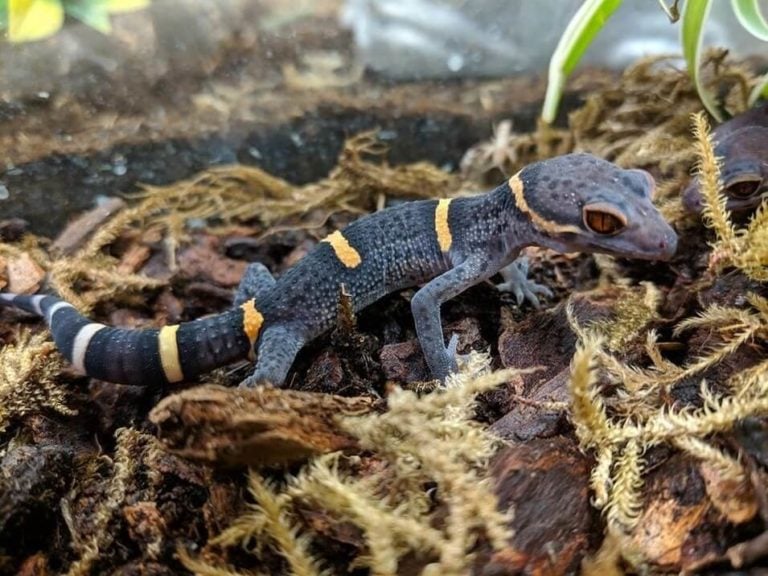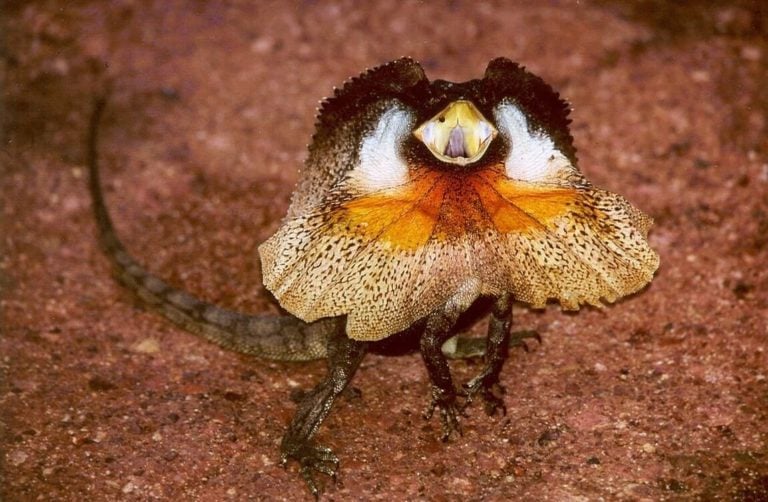As you feed your gecko its favorite live insects, you may notice an odd dark patch under its belly.
Dark spots in your leopard gecko can indicate multiple health complications. It might be a parasite, stress, shedding, internal bleeding, or impaction.
The good news is that each issue can be resolved with professional treatment and prevention methods.
Stick around to learn more about the causes of black spots on your leopard gecko and what you can do about it.
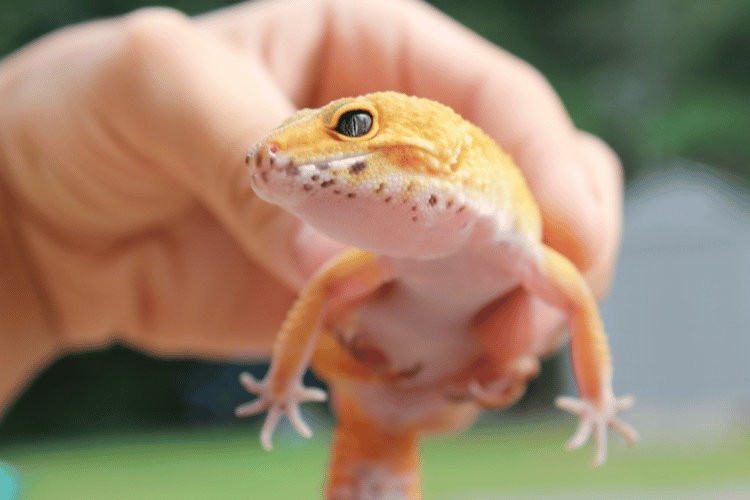
Why Are There Black Spots on Your Leopard Gecko?
In most cases, the dark spots on your leopard gecko will appear on its underbelly. These dark patches can come from various reasons, such as a parasite, impaction, or, in severe cases, internal bleeding.
It Could Be Natural
Sometimes, the dark spots on your gecko’s underbelly could be no cause for concern. Your leopard gecko may naturally have translucent skin. When it munches on the substrate, you might see it through its skin as it digests.
We suggest monitoring your leopard gecko to ensure the dark patches are natural. Their waste should pass with no issue. Plus, keep your eye on their drinking and eating habits. Notice any signs of loss of appetite or stress.
Parasitic Infection
Your leopard gecko’s discolored underbelly could signify a parasitic infection. Two of the most widespread parasites in geckos are coccidia and pinworms. Geckos can contract these infections through contagion from other infected tankmates.
Alternatively, the parasite can come from their poor-quality meals. Plus, you’ll also want to evaluate the terrarium. The substrate may be carrying the infection.
If you want to confirm that parasites are the culprit, a stool sample test is necessary. Bring a sample of your gecko’s stool to your vet.
Besides that, these parasites carry several health risks for your Leo. On top of the black patches, other symptoms could appear, such as:
- Loss of appetite
- Weight loss: This symptom will likely appear first on their tail, where they store most of their fat reserves.
- Lethargy
- Diarrhea
- Odorous stool
- Vomiting
Stress
Even though geckos are cold-blooded reptiles and are incapable of expressing complex emotions, they still feel stressed. It can happen for multiple reasons, such as environmental changes, such as
Lighting
For instance, you might’ve moved your Leo’s tank next to a window where lots of sunlight appears. If you moved the terrarium from a more secluded spot, that could mess with their circadian rhythm since they were initially used to a dimly lit space.
As crepuscular creatures, leopard geckos are active during dusk and dawn. In turn, you also wouldn’t want to place a light fixture near them at night.
Tankmates
Your Leo may be used to being an only child. If you introduce a new gecko to its tank, it can take time to adjust. Now, you wouldn’t want to add a gecko of the same gender.
These reptiles can get territorial and temperamental with each other, especially the males. It can result in bullying behavior and fights, leading to fatal injury.
Physical Handling
Leopard geckos can get stressed from being handled. Geckos need to feel safe and ready before being touched. Otherwise, you’ll notice the gecko hiding a lot more. Plus, it could potentially drop its tail when feeling threatened during handling.
Temperature Imbalance
A sharp rise or decrease in your leopard gecko’s tank temperature can lead to stress. Fluctuating humidity can also bother your pet. That said, environmental changes can come from the surroundings.
For instance, placing your gecko’s terrarium next to a window on a warm day can increase temperatures. Some leopard gecko owners may have cheap thermometers with inaccurate readings.
For this reason, you’ll want to keep your Leo away from heaters and air conditioners. Invest in a functional temperature gun. You can place your gecko near a window as long as the temperature isn’t drastically different from indoors.
Signs of Stress
If you suspect that stress could be causing the dark spots to appear on your gecko’s underbelly, here are some signs to consider:
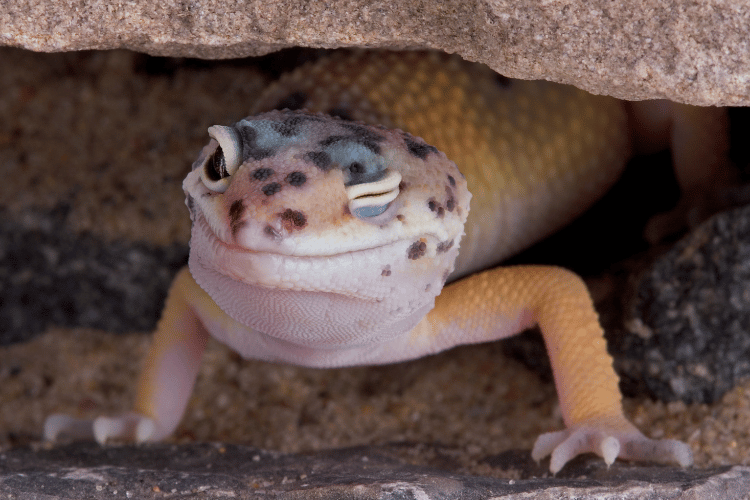
- Appetite loss
- Wagging tail
- Chirping and squeaking noises
- Skittish behavior
- Hiding
- Digestive trouble
- Digging
- Glass surfing
Internal Bleeding
Internal bleeding is a highly severe medical issue that can cause dark spots on your gecko’s underbelly. It requires immediate veterinarian attention.
The issue can come from various reasons, such as improper substrate causing impaction. In addition, you have accidentally mishandled your Leo.
You can identify internal bleeding from other symptoms, such as a white tongue, appetite loss, blood in stool, and lethargy. That said, you can’t do much at your home to remedy internal bleeding.
The first aid measures you can take are increasing the tank temperature and giving your gecko a soak. You can also create a half-and-half Pedialyte and water solution for the soak.
Shedding
As your leopard gecko approaches adulthood, shedding is just around the corner. Discoloration can often be a sign of stuck skin. The piece isn’t able to loosen from your gecko’s skin, which can tighten and inhibit blood supply to the area.
Even though it’s usually more common around the legs and toes, it can happen on your Leo’s underbelly. Fortunately, you can solve this issue by incorporating more moisture and humidity into the terrarium to ease the shedding process.
A warm bath soak can also remove the excess skin. Nevertheless, you’ll want to consult your vet before doing so.
Impaction
Impaction in leopard geckos occurs when stool is too hard to move through their digestive tract. In turn, it creates a blockage which can lead to deterioration of the digestive system, organ failure, and death.
The medical issue can come from feeding on an improper substrate and overly large live feed. Younger Leos are more vulnerable to impaction due to their small bowels.
You can tell your reptile pet is constipated from symptoms like not eating, bloating, lethargy, cloaca licking, and weight loss.
We highly recommend monitoring your gecko’s bathroom habits to ensure that they’re pooping consistently. If impaction signs are persistent, you’ll need to visit your vet to tackle the issue promptly.
You may also want to grab a piece of cloth and dampen it with warm water and gently rub your gecko’s belly with it. It’ll ease digestion and soften the stool. Nonetheless, this will require a lot of handling, which can stress your pet. Consequently, a vet visit is the best course of action.
Black Spots on Leopard Gecko: Prevention Methods
Of all the causes of black patches appearing on your gecko, impaction is one of the most common causes. Luckily, there are ways you can prevent it from occurring.
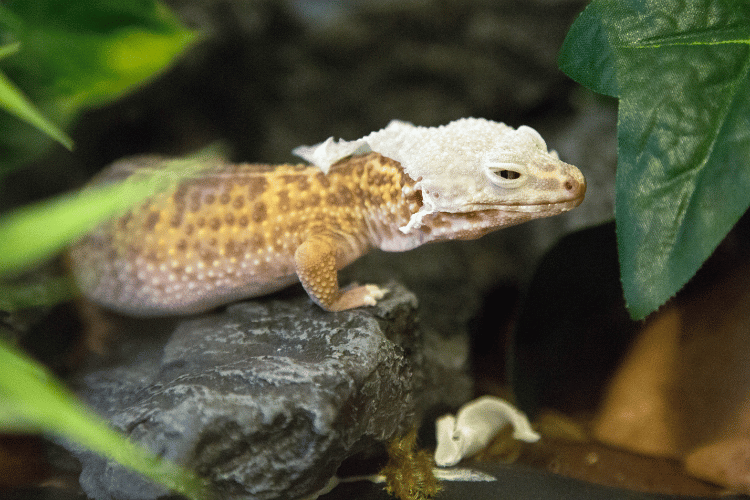
Monitor Feed
Don’t feed your gecko loose substrate and large live feed. The reptile should consume a healthy dosage of mealworms, crickets, fruit flies, grasshoppers, or wax worms. Make sure they’re not too large for the gecko’s tiny bowels.
As a general rule of thumb, your geckos can eat insects that are within the length of the space between their eyes.
Ensure Fiber Intake
Just like humans, geckos need fiber to improve digestion and prevent constipation. Now, leopard geckos are purely insectivores. In turn, they can’t eat anything else other than insects. Despite being fiber-rich, vegetables are not recommended for leopard geckos.
That said, you can enrich your reptile’s diet with gut-loaded feed. It means that the insects you feed them should have nutrients in their gut. To do so, you’ll have to purchase the live feed ahead of time.
Next, keep them in a faunarium and provide a daily intake of cabbage, apples, cut grapes, and other fruits and vegetables. Make sure they’re safe to consume for your gecko.
For example, avocados can be toxic to leopard geckos. Lastly, feed your gut-loaded insects to your reptile.
Keep Gecko Hydrated
Additionally, ensure the reptile is well-hydrated. You can mist the gecko regularly and be sure to keep its water bowls filled.
Use Proper Substrate
Loose substrates like wood shavings and sand can cause impaction. In turn, you’ll want to keep your pet reptile housed in flat, carpeted flooring. You can use paper towels as well.
Aside from that, they should have a feeding platter rather than eat from the floor. Otherwise, they might accidentally pick up unwanted debris.
Monitor Pooping Habits
One of the best ways to get ahead of impaction is to keep tabs on your pet gecko’s pooping behavior.
Young geckos typically poop multiple times daily. Meanwhile, adults will defecate every few days. If it’s been more than that, it’s time to visit your exotic vet.
Final Thoughts
Why does your leopard gecko have black spots under its belly? In short, it could be anything from a parasitic infection to stress. One of the most serious cases would be internal bleeding, but that’s relatively uncommon.
On the other hand, one of the most popular causes is impaction or constipation. With such small bowels, blockage can happen from the wrong feed and dehydration.
Fortunately, you can overcome these issues by ensuring a healthy diet, free of loose substrate, proper hydration, and poop tracking.

